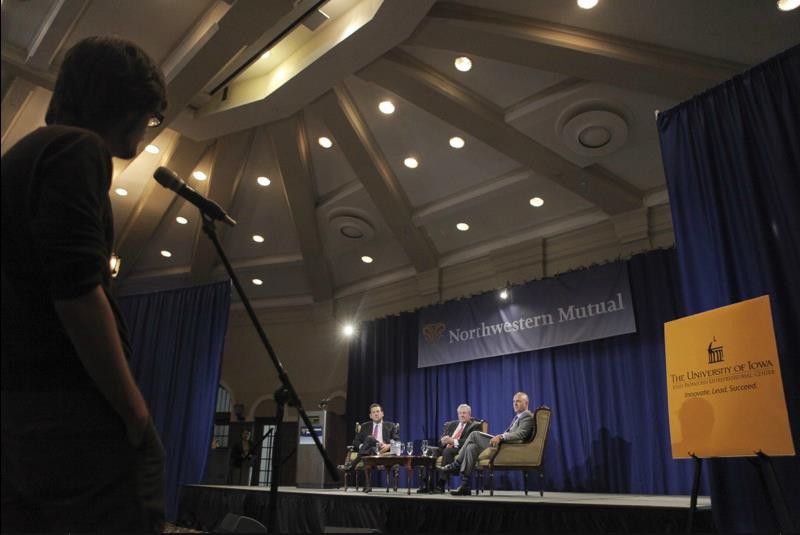
I’ve loved Facebook’s On This Day tool ever since Jonathan Gheller told us all that it existed.
If you’re having one of those days like I am where you feel the urge to have nostalgia about the techniques facilitating nostalgia, you’re more than welcome to start with the announce here and work your way back. There’s also Jillian D’Onfro ‘s delightful look at the way the widget works. aaand I’d be remiss if I didn’t also mention Christine Lariviere for her exquisitely wonky dive on nostalgia.
This morning, as I was taking my first glance through my feed I was reminded of a time I asked Steve Forbes an in-artful question about digital transformation.
 > Tangent: If you really want to wonk out, I uploaded a rough bootleg at the time.
>
> I vaguely remember being incredibly concerned about the ways in which one could manage the increasing tendencies of platforms to prioritize natively posted content over other methods of hosting. I remember being concerned by the way in which organizations would adapt to a media landscape that was more about who we were reaching and what we were saying to them when we did it.
> Tangent: If you really want to wonk out, I uploaded a rough bootleg at the time.
>
> I vaguely remember being incredibly concerned about the ways in which one could manage the increasing tendencies of platforms to prioritize natively posted content over other methods of hosting. I remember being concerned by the way in which organizations would adapt to a media landscape that was more about who we were reaching and what we were saying to them when we did it.
Everything was newer then. There weren’t as many people talking about the importance of paying attention to the basics like how long users were using your product or how you might use that information to change the way you crafted your product or service’s messaging funnel.
There weren’t as many people talking about the same handful of phrases and expressing the same laments about being overworked, about long hours and platforms that were evolving faster than anyone could really hope to stand up real process around.
 It was easier to try new things, because good ideas people hadn’t tried before took time. It’s hard to remember now, but there was an era where you couldn’t just add zip codes into Facebook en masse. Believe it or not, there was a time when you might have been excited to discover the Twitter lead card.
It was easier to try new things, because good ideas people hadn’t tried before took time. It’s hard to remember now, but there was an era where you couldn’t just add zip codes into Facebook en masse. Believe it or not, there was a time when you might have been excited to discover the Twitter lead card.
But those times seem to have faded.
I’m not the first to write something like this, but as I look at the landscape today, I see a handful of features that I think are worth taking a moment or two to reflect on. Specifically, I want to talk about three ideas that I used to hear about a lot more frequently than I do now. I think that’s a shame.
 The first thing: I remember when assembling a target took work. One might expect to spend weeks working out little measurements using small ads with test budgets and carefully curated lists one spent hours painstakingly managing in Google Sheets.
The first thing: I remember when assembling a target took work. One might expect to spend weeks working out little measurements using small ads with test budgets and carefully curated lists one spent hours painstakingly managing in Google Sheets.
That ability has proved itself useful in a boundless number of contexts. When you’re working with ad platforms that are still developing their capabilities, it’s a benefit. When you’re working to tease out the volume of real users in an audience, it’s a benefit. When you’re working to develop a user testing program, it can help you to manage your recruitment efforts. When you’re looking to validate a market it can help you to identify perspectives that you hadn’t noticed before.
It’s possible that an entire generation of emerging marketing leaders won’t ever learn this skill as now the process is far more automated. That’s a real shame.
The second thing I remember quite fondly was the way in which each bit of decision making about what people liked was made by watching what they said and assuming they were smart enough to mean it.
I didn’t notice this one change — but I did notice when it had.
 Early on, I remember lots of folks saying things about just how important it was to start off any project by taking the time to work through scores of answer boards, forums and twitter posts to find what people really cared about.
Early on, I remember lots of folks saying things about just how important it was to start off any project by taking the time to work through scores of answer boards, forums and twitter posts to find what people really cared about.
Everyone seemed so excited by the prospect of being able to get closer to true 1:1 messaging. It wasn’t about the efficiency or the cost per engagement, it was about the person and the business and their relationship.
Those things aren’t easily lost once you replace them with perspectives you’ve gathered from sterile reports and user studies about tests you didn’t conduct yourself. They’re the context you’re missing when you read about the latest “bomb” strategy or tactics for getting that extra email sign up or the attention from that contact you’ve been chasing for weeks.
 The problem with these one size fits all approaches is that they force your uses to conform to your process. That’s backward, and it ought to work the other way around.
The problem with these one size fits all approaches is that they force your uses to conform to your process. That’s backward, and it ought to work the other way around.
There’s a good chance that you’ll need more than a handful of approaches to accommodate the four or five largest patterns in your data, but I can promise you it will be worth the extra effort.
The third thing I want to mention here that I think we’ve started to lose is the idea that our skillset is accessible to anyone willing to put in the work to figure out a new solution to a problem. It’s the idea that once you’ve done that you have an obligation to turn around and share that insight with the community that you have come to be a part of.
I remember the first time I knew I needed to deploy a campaign across multiple channels, for multiple clients at once. I didn’t know how to do that. I had done the parts of it before, but never all together, and never relying on the processes, tools and techniques I had come to know as “best practices.”
 I needed counsel. I turned to the community.
I needed counsel. I turned to the community.
I spent every second I could reading from the successes and failings of those who had gone before me. In so doing, I learned about new disciplines and new possibilities.
I didn’t need to sign up for a course or take a test.
I had to show up and put in the work.
There’s something magical about that simple truth, that the skills we all rely on every day aren’t magic — they’re things that we can learn. They’re there for anyone to adopt, to scrutinize to wrestle with and improve.
With time, I had mastered those skills and now I find myself frequently sharing that wisdom with others.
In so doing, I’ve noticed a growing number of folks who have come to believe that the only way to learn a subject as complex as that of the industry we find springing up about ourselves is to get involved with a course or to go back to school.
 There’s nothing inherently wrong with those things, and for many, many people they can represent a powerful way of learning — but learning through practice is one of the best experiences you can have in a career, and this is one of the few industries where it’s a realistic possibility.
There’s nothing inherently wrong with those things, and for many, many people they can represent a powerful way of learning — but learning through practice is one of the best experiences you can have in a career, and this is one of the few industries where it’s a realistic possibility.
If you aren’t sure how to grow a social media following, finding an underserved niche and spending two or three hours trying to figure out how to make things work is one of the fastest ways to start developing the skills you’ll need to thrive. When you run into trouble, stop and look around and see if anyone else has had the same trouble before.
When you do, you’ll find something. Even if you truly are out on your own, you’re almost certain to find scores of great pieces about what you can learn and what you should be thinking about.
Commanding those powerful insights enable you to quickly adapt to any change the landscape can throw at you. It works because it makes you a better marketer by making you a more informed professional.
I don’t know that these are the only lessons that are worth learning, but I do know that they’ve always provided me with a great bit of clarity as I’ve worked to find solutions to problems that don’t always have obvious answers. I’ll bet that in the next five years, they’ll help you, too.
 Three Things We’re At Risk Of Forgetting About What Drives Growth A Half Decade On was originally published in Marketing And Growth Hacking.
Three Things We’re At Risk Of Forgetting About What Drives Growth A Half Decade On was originally published in Marketing And Growth Hacking.

Twitter
Facebook
Reddit
LinkedIn
StumbleUpon
Pinterest
Email